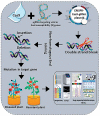Engineering disease resistant plants through CRISPR-Cas9 technology
- PMID: 33079628
- PMCID: PMC7583490
- DOI: 10.1080/21645698.2020.1831729
Engineering disease resistant plants through CRISPR-Cas9 technology
Abstract
Plants are susceptible to phytopathogens, including bacteria, fungi, and viruses, which cause colossal financial shortfalls (pre- and post-harvest) and threaten global food safety. To combat with these phytopathogens, plant possesses two-layer of defense in the form of PAMP-triggered immunity (PTI), or Effectors-triggered immunity (ETI). The understanding of plant-molecular interactions and revolution of high-throughput molecular techniques have opened the door for innovations in developing pathogen-resistant plants. In this context, Clustered Regularly Interspaced Short Palindromic Repeats (CRISPR)-CRISPR-associated protein 9 (Cas9) has transformed genome editing (GE) technology and being harnessed for altering the traits. Here we have summarized the complexities of plant immune system and the use of CRISPR-Cas9 to edit the various components of plant immune system to acquire long-lasting resistance in plants against phytopathogens. This review also sheds the light on the limitations of CRISPR-Cas9 system, regulation of CRISPR-Cas9 edited crops and future prospective of this technology.
Keywords: CRISPR-Cas9; Gene editing; biotic stress; disease Resistance; plant immune system; susceptible genes.
Figures




References
Publication types
MeSH terms
LinkOut - more resources
Full Text Sources
